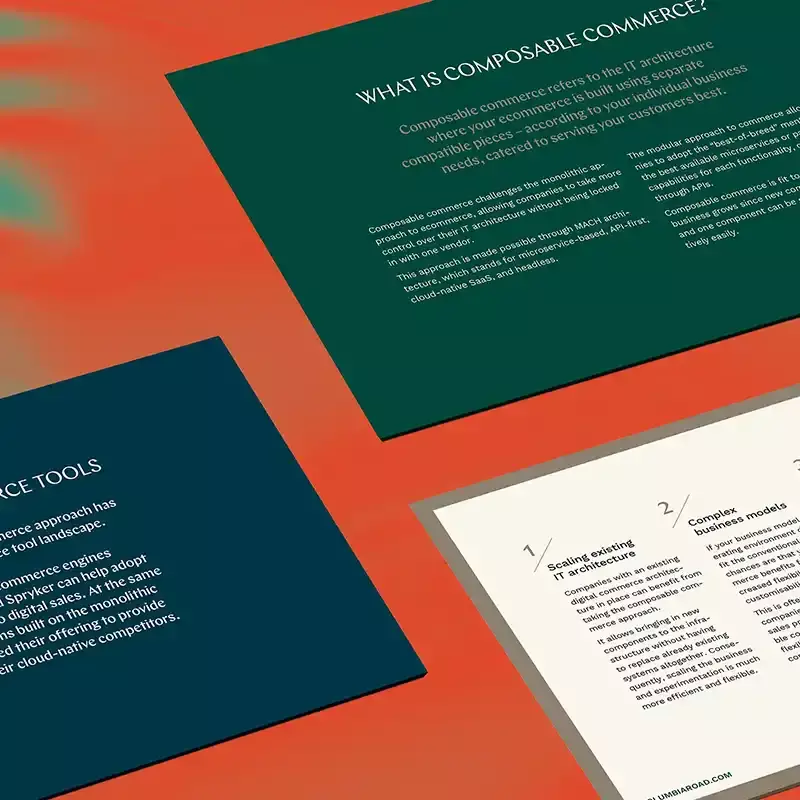The B2B buyer’s journey and sales process can feel overwhelmingly complex. Unlike often straightforward B2C transactions, B2B sales processes often involve multiple stakeholders, a blend of digital and physical touchpoints, and highly customised solutions. It’s rarely a linear path. That’s why we created the B2B Digital Sales Canvas – a practical tool to help you make sense of the complexity.
What is the B2B Digital Sales Canvas?
The canvas is a framework designed to connect your buyer’s journey with your internal marketing, sales and service activities. Too often, these are treated as separate tracks. The canvas helps you bring them together on one page.
In a single view, you can:
- Identify business goals and key buyer personas
- Map customer goals and information needs
- Align internal activities, data and applications
- Spot opportunities for automation and intelligence
The canvas ensures your teams work in unison, creating a smoother, more effective operation that better serves your customers.
Start with why: scoping your project
Before diving into the canvas, take a step back. What is the core business objective driving this project? Without focus, the canvas can feel overwhelming. Ask yourself:
- What problem are we solving?
- What is our company’s goal for the coming years?
For instance:
- If your goal is new customer acquisition, focus on the early journey stages: awareness, consideration, and decision & purchase.
- If you want to reactivate dormant accounts, look to the post-purchase, usage, loyalty, and advocacy phases.
Remember: one canvas may not fit every need. You might benefit from separate canvases for different business units, countries, or product lines. This targeted approach keeps the project manageable and closely tied to your strategic goals. Check out our other canvases and tools here.
Mapping the B2B stakeholder web
B2B purchases rarely rest on a single person's decision. They involve a network of stakeholders, each with unique goals and information needs. The canvas helps you map these personas, from decision-makers to end-users, and understand their influence.
Take a manufacturing example: the budget approver may not be the primary driver. A mechanical contractor might place the order, but they are often influenced by a consultant who drafts project specifications. That consultant works on behalf of a building owner, whose priorities, such as energy efficiency, guide the project and budget.
When filling the canvas, distinguish between primary personas and influencers. This helps you focus on those who directly engage with your product, while still accounting for the wider web of influence. The aim is to deliver a seamless, value-driven experience that resonates with each stakeholder, regardless of their role.
Building the journey: touchpoints and processes
B2B sales journeys are defined by a mix of digital and physical interactions. A customer might encounter your company through a LinkedIn post, a face-to-face meeting, or a phone call long before accessing your webshop or portal.
The canvas enables you to map this journey as it really is, not as you assume it to be. Use both:
- Qualitative data: conversations with customers
- Quantitative data: analytics and behavioural insights
This holistic approach highlights gaps, fragmentation, and opportunities. For example, the absence of a webshop may leave critical touchpoints overly reliant on manual processes. These insights form the foundation for a backlog of improvements.
The power of internal alignment
Understanding the customer journey is one thing; making sure your internal processes are aligned to support it is another. The B2B sales process involves many moving parts, and if they are not optimised, you create unnecessary friction for both your team and your customers. This complexity is often linked to the high degree of customisation required for B2B offerings.
You are rarely just selling a product; you are selling a solution tailored to a customer’s specific needs. That is why it is important to conduct one-on-one interviews with your team. This goes beyond spotting problems. It is about understanding their reality and how they currently support that customisation.
Team interviews are key. They reveal not just pain points but also the workarounds your team relies on. For example:
- Sales professionals are slowed down by quoting processes requiring multiple disconnected systems.
- Time-consuming manual tasks like tracking outstanding quotes and sending follow-up emails, all ripe for automation.
- CRM systems that fail to meet local needs, leading to incomplete or inaccurate data.
Sometimes, the internal activities themselves hinder the optimal customer experience. A sales manager may be dissatisfied with the CRM data, but the sales team is not logging it because the system is not configured for their local requirements. These are the hidden inefficiencies that our canvas helps uncover. By engaging directly with your team, you can uncover these challenges and the manual workarounds they have developed.
A key thing to remember: this is not about automating jobs away. It is about automating repetitive, manual tasks to free up your team’s time for more valuable work, such as building relationships and strategising with key accounts. The canvas helps you see how your internal processes can be optimised to handle customisation, ensuring you can deliver a solution that provides real value.
By mapping these challenges, you can identify opportunities to enhance internal processes and streamline both your team’s work and your sales process.

Make it a living, evolving document
Think of the canvas not as a one-time workshop deliverable but as a tool that should grow and adapt with your organisation. Treat it as a shared reference point that evolves as your business objectives, customer needs, and technologies change.
The structured approach
- Start with the "Why": Begin by mapping your objectives and business goals. As we’ve discussed, this is the most critical step to ensure you stay focused on the relevant customer journey and sales process.
- Map the journey and process: This is where you connect the dots. The canvas provides a side-by-side view of the customer's journey and your internal sales process. These can be conducted independently: you can either focus first on mapping the internal sales processes or start by mapping the buyer's journey. You’ll map everything from the customer's information needs to your team's internal activities and the data they use.
- Identify and act on opportunities: Once you have a complete map of the journey and have identified possible gaps or needs for improvement, it's time to create your backlog. This is where the real work begins: prioritising what to tackle first and identifying new growth ideas.
The B2B Digital Sales Canvas is a tool for alignment and growth. It helps you consider your customer's experience from awareness to loyalty while simultaneously improving your internal sales processes. Although it may be a complex landscape, with the correct map, you can navigate it effectively.
B2B Digital Sales Canvas
Streamline your B2B sales process with this practical, easy-to-use canvas.
Get the canvas




